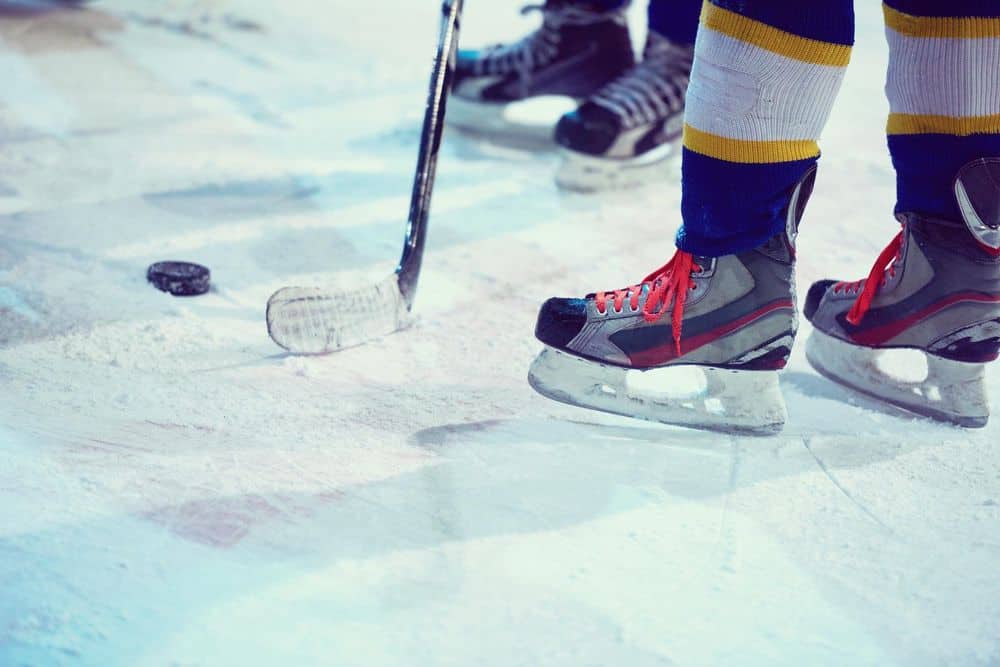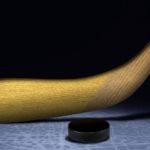Do figure skaters possess the ability to execute a hockey stop on their figure skates? In this informative article, we explore the possibility of performing this maneuver on figure skates and examine the key differences between hockey skates and figure skates.
While figure skaters may utilize similar techniques, their emphasis lies on balance and control rather than speed and agility. We also discuss the importance of the toe pick in figure skates and the benefits of learning both figure skating and hockey.
Join us as we delve into the intriguing world of figure skating and hockey fusion.
Hockey Stop in Figure Skating
Figure skaters can perform a hockey stop, albeit with a greater emphasis on balance and control. While hockey players execute this maneuver to quickly change direction and chase the puck, figure skaters focus on maintaining their graceful posture and precise movements.
In a hockey stop, figure skaters may choose to use only one skate instead of both, allowing for greater control but a slower stop. This attention to detail reflects the importance of balance and control in figure skating stops.
Posture plays a crucial role in executing a successful hockey stop on figure skates. Skaters must distribute their body weight slightly more on the front skate while maintaining proper arm positioning. This ensures stability and control during the stop.
Comparison of Skates: Hockey Vs. Figure
When comparing the design and functionality of hockey skates and figure skates, it becomes evident that these two types of skates serve different purposes.
Here are some key differences:
- Design:
- Figure skates are lighter and more pliable than hockey skates.
- They have longer blades for better balance and smooth movement.
- Figure skates also have a toe pick for jumping and tight spins, which hockey skates lack.
- Ankle Support:
- Hockey skates offer enhanced ankle support and protection against pucks.
- They are designed for the fast-paced and physical nature of ice hockey.
- Stopping Methods:
- Figure skaters use different stopping methods like the snowplow and t-stop.
- Hockey players rely on the hockey stop for quick turns and chasing the puck.
- Versatility:
- Figure skates are specialized for figure skating maneuvers, such as spins and jumps.
- Hockey skates are designed for the demands of ice hockey.
Explanation of a Hockey Stop
To fully understand the mechanics behind a hockey stop, what is the key technique that hockey players utilize?
The key technique that hockey players utilize for a hockey stop is skidding both skates in the same direction against the ice. This flashy and efficient move allows players to quickly stop and change direction on the ice. It requires distributing body weight slightly more on the front skate and results in a characteristic spray of ice.
While figure skaters can perform a hockey stop, they emphasize balance and control, often using only one skate for greater control but a slower stop. It is important for figure skaters to pay attention to details like posture and arm positioning when performing a hockey stop. Additionally, figure skaters also learn various stopping methods such as the snowplow and t-stop.
These techniques for better control are crucial for both hockey players and figure skaters to master.
Performing a Hockey Stop With Figure Skates
Performing a hockey stop with figure skates requires meticulous attention to details such as posture and arm positioning, as figure skaters aim to achieve both control and precision on the ice. Here are some key points to consider when attempting to master the hockey stop on figure skates:
- Adjust your posture: Maintain an upright position with your knees slightly bent and your weight evenly distributed between both skates. This will provide stability and balance during the stop.
- Arm positioning: Keep your arms relaxed and slightly extended in front of you. This helps with maintaining balance and provides additional stability.
- Focus on your edges: Figure skates have longer blades compared to hockey skates, allowing for better balance and smoother movement. Utilize the inside edges of your skates to dig into the ice and create the necessary friction for the stop.
- Practice and patience: Mastering the hockey stop on figure skates may take time and practice. Start by practicing on a less crowded area of the ice, gradually increasing your speed and incorporating the stop into your skating routine.
Transitioning From Figure Skates to Hockey Skates
Transitioning from figure skates to hockey skates can be a challenging adjustment for skaters. It requires adapting to the different design and function of hockey skates, which lack the toe pick that figure skaters rely on for stopping and accelerating.
Initially, skaters may struggle to achieve the same level of control and stability on hockey skates. However, with practice and time, the transition can be successfully made.
In fact, learning both figure skating and hockey can have numerous benefits through cross-training. Figure skating basics, such as developing balance, posture, and other essential skills, can enhance a skater’s overall flexibility and skating abilities.
This combination of skills can make a skater more well-rounded and adaptable, allowing them to excel in both figure skating and hockey.
Balance and Control in Figure Skating
As figure skaters transition from using figure skates to hockey skates, they must adapt to a different design and function, which requires a greater emphasis on balance and control. In figure skating, balance and control are crucial for executing intricate figure skating techniques and maintaining stability on the ice.
Here is the importance of body positioning in figure skating:
- Alignment: Proper alignment of the body is essential for maintaining balance and control. Skaters must align their shoulders, hips, and knees to ensure stability.
- Core strength: A strong core helps skaters maintain balance and control during spins, jumps, and intricate footwork. It provides stability and allows for better body control.
- Weight distribution: Skaters must distribute their weight evenly between both skates to maintain balance and control. Shifting weight from one foot to another aids in executing various figure skating maneuvers.
- Posture: Good posture is essential for maintaining balance and control. Skaters should keep their head up, shoulders back, and spine aligned to achieve optimal body positioning.
Single Skate Stopping in Figure Skating
Single skate stopping in figure skating requires precise technique and control.
While figure skaters typically use both skates to stop, they can also perform a single skate stop for added control and finesse.
This technique involves using only one skate to slow down and come to a stop. Mastering balance and control is essential when executing this maneuver, as it requires distributing weight correctly and maintaining stability on a single skate.
By utilizing the single skate stop, figure skaters can showcase their skill and artistry while maintaining control over their movements.
It is important to note that this stopping method is not commonly used in figure skating, but it can be a valuable addition to a skater’s repertoire.
Different Stopping Methods in Figure Skating
Figure skaters employ a variety of stopping methods to control their movements on the ice. These stopping methods are crucial for maintaining balance, changing direction, and executing various maneuvers. Here are four different stopping methods commonly used in figure skating:
- Snowplow Stop: This method involves turning the toes of both skates inward and pushing the heels outward, creating a wedge shape with the blades. It allows skaters to gradually slow down and come to a complete stop.
- T-Stop: In this method, skaters drag one foot perpendicular to the other, forming a T-shape with their skates. It provides a quick and effective way to reduce speed while maintaining control.
- One-Foot Stop: Skaters can use one foot to execute a stop by turning the skate sideways and pressing the inside edge against the ice. This method requires excellent balance and control.
- Spread Eagle Stop: This stop involves spreading the legs wide apart while gliding on the inside edges of the skates. It offers a visually appealing stop and requires good flexibility and body control.
In figure skating, proper posture is crucial for executing these stopping methods effectively. Skaters need to maintain a balanced and upright position, with their chest lifted, shoulders back, and core engaged. Good posture allows for better weight distribution and control, enabling skaters to execute stops with precision and grace.
Design and Function of Hockey Skates
Continuing the discussion on stopping methods in figure skating, let’s now delve into the design and function of hockey skates.
Hockey skate technology has evolved over the years to meet the specific needs of hockey players on the ice. Unlike figure skates, hockey skates are designed for speed, agility, and quick turns. They feature a rigid boot that provides ankle support and protection against pucks.
The blade design of hockey skates is also different, with shorter blades that allow for more maneuverability. The focus is on stability and control rather than the longer blades found in figure skates, which prioritize balance and smooth movement.
Additionally, hockey skates lack the toe pick found on figure skates, as they are not designed for jumps and spins. Overall, hockey skate design and function cater to the fast-paced, physical nature of the sport.
Design and Function of Figure Skates
Figure skates are meticulously crafted to deliver optimal performance on the ice. Here are some key aspects of the design and function of figure skates:
- Lightweight and Flexible: Figure skates are lighter and more pliable than hockey skates. This allows skaters to execute intricate footwork and graceful movements with ease.
- Longer Blades: Figure skates have longer blades compared to hockey skates. This provides better balance and stability on the ice, allowing skaters to perform jumps, spins, and other intricate maneuvers.
- Toe Pick: Figure skates are equipped with a toe pick, a small jagged edge at the front of the blade. This feature is essential for executing jumps and tight spins, providing grip and stability.
- Maintenance and Blade Sharpening: Proper figure skate maintenance includes regular blade sharpening. Skaters must ensure their blades are sharp to maintain control and maneuverability on the ice. Regular professional sharpening is recommended to optimize performance.
Enhanced Ankle Support in Hockey Skates
The design of hockey skates incorporates advanced features to provide exceptional ankle support. Unlike figure skates, which prioritize flexibility and mobility, hockey skates are specifically engineered to offer enhanced stability and protection to the ankles. This is crucial in a high-impact sport like hockey, where players frequently make rapid changes in direction and engage in physical contact.
The benefits of this enhanced ankle support are twofold. Firstly, it helps to prevent injuries such as sprains and fractures by minimizing the risk of the ankle rolling or twisting. Secondly, it enables players to generate more power and control in their movements, allowing for quick acceleration, sharp turns, and powerful stops.
Longer Blades for Better Balance in Figure Skates
Longer blades contribute to improved balance in figure skates. Here are four reasons why figure skates with longer blades provide better balance:
- Increased stability: Longer blades offer a larger contact area with the ice, providing skaters with enhanced stability and control. This allows figure skaters to execute intricate footwork and complex maneuvers with ease.
- Smoother gliding: Figure skates with longer blades allow for longer and smoother glides across the ice. The extended length minimizes the risk of catching edges and stumbling, enabling skaters to maintain their balance and flow.
- Improved weight distribution: The longer blades distribute the skater’s weight more evenly, helping to maintain a centered and balanced position. This balance is crucial for executing jumps, spins, and intricate footwork sequences.
- Enhanced edge control: The longer blades provide skaters with better control over the edges of their skates. This allows for precise movements and sharper turns, contributing to better overall balance on the ice.
Toe Pick: A Key Feature in Figure Skates
Figure skates have a key feature known as the toe pick. This small, jagged edge at the front of the blade is a distinctive characteristic of figure skates and plays a crucial role in figure skating techniques. Unlike hockey skates, which lack a toe pick, figure skates use the toe pick for various maneuvers such as jumps and tight spins. The toe pick provides stability and grip on the ice, allowing figure skaters to execute precise movements with ease. It also assists in stopping and accelerating, giving skaters greater control over their speed and direction. However, it is important to note that attempting figure skating techniques on hockey skates is not recommended, as they are not designed for spins and jumps, increasing the risk of falling. Figure skaters learn specific stopping methods like the snowplow and t-stop when transitioning to hockey skates. The table below highlights the key differences between figure skates and hockey skates.
| Figure Skates | Hockey Skates |
|---|---|
| Lighter and more pliable | Heavier and more rigid |
| Longer blades for better balance | Shorter blades for quick turns |
| Toe pick for jumping and tight spins | No toe pick |
| Not suitable for hockey maneuvers | Designed for quick movements and chasing the puck |
The toe pick in figure skates serves as a fundamental tool for figure skaters, allowing them to perform intricate moves and maintain stability on the ice.
Benefits of Learning Both Figure Skating and Hockey
Learning both figure skating and hockey offers numerous benefits for hockey players. Here are four key advantages of incorporating figure skating into a hockey player’s training regime:
- Enhanced Balance and Agility: Figure skating focuses on balance, posture, and precise movements, which can greatly improve a hockey player’s overall agility on the ice.
- Improved Edge Control: Figure skates have longer blades and are designed for smooth gliding and precise edge control. Learning to maneuver on figure skates can help hockey players develop better control and stability when making sharp turns and quick stops.
- Increased Creativity and Artistry: Figure skating encourages creativity and expression through intricate footwork and graceful movements. Incorporating figure skating elements into hockey can add a unique flair to a player’s style and improve their overall performance.
- Injury Prevention: Figure skating helps develop proper technique and body awareness, which can reduce the risk of injuries in hockey. It strengthens the core, improves flexibility, and promotes better body alignment, ensuring players can withstand the physical demands of the game.
Frequently Asked Questions
Can Figure Skaters Perform a Hockey Stop?
Figure skaters can perform a hockey stop, although it is not commonly used. They may use a single skate instead of both. Figure skates require more attention to details like posture and arm positioning.
Can Figure Skaters Use a Single Skate to Stop?
Figure skaters can use a single skate to stop, but it requires attention to details like posture and arm positioning. Performing figure skating maneuvers on hockey skates is not recommended due to design differences and increased risk of falling.
Are Hockey Stops Commonly Used in Figure Skating?
Hockey stops are not commonly used in figure skating. However, figure skaters can perform a hockey stop, often using a single skate for greater control. Other stopping methods like the snowplow and t-stop are more frequently employed.
What Are the Different Stopping Methods Used in Figure Skating?
Figure skaters utilize various stopping methods, such as the snowplow and t-stop, to control their movement on the ice. These techniques emphasize proper posture and arm positioning, ensuring balance and control during stops.
Is It Recommended to Attempt Figure Skating Maneuvers on Hockey Skates?
Attempting figure skating maneuvers on hockey skates is not recommended due to safety concerns. Hockey skates lack the necessary toe pick for stopping and accelerating, increasing the risk of falls and injuries. It is best to use appropriate equipment for each respective activity.
Conclusion
In conclusion, while figure skaters can execute a hockey stop on their figure skates, their focus is on balance and control rather than speed and agility. Utilizing a single skate for stopping provides greater control but results in a slower stop.
It is important to note that attempting figure skating maneuvers on hockey skates is not recommended due to the lack of a toe pick. However, practicing skills in both figure skating and hockey can enhance overall flexibility and skating abilities.
So, lace up your skates and explore the world of figure skating and hockey to unlock your full potential on the ice!









